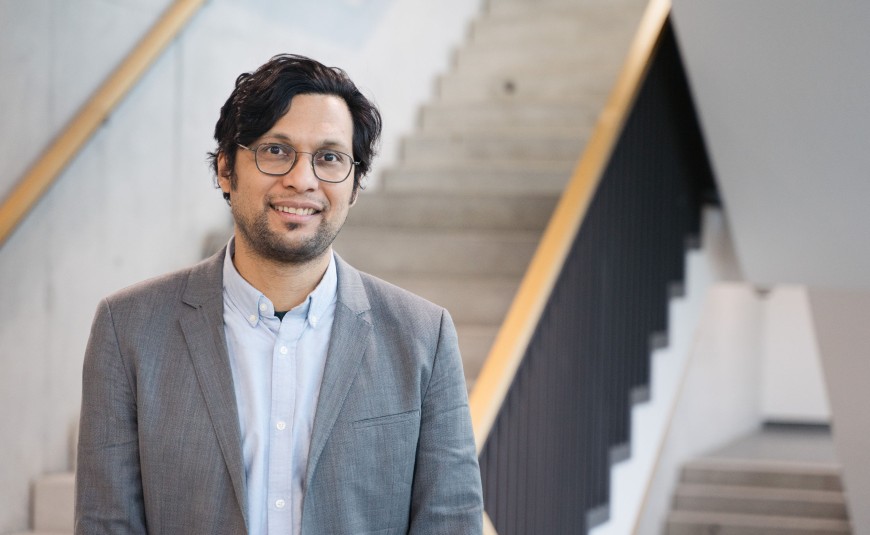A look at the activity in electronic components
Professor Leopoldo Molina-Luna receives ERC Consolidator Grant
2023/01/31
In its current funding round, the European Research Council ERC has awarded Professor Leopoldo Molina-Luna a Consolidator Grant of around 2.1 million euros for his project “ELECTRON – Enabling spatially-resolved mapping of electric activity in operational devices at atomic-resolution”.

Advanced materials are at the heart of 21st-century innovation. They are used in a variety of industries such as semiconductors, consumer electronics, automobile manufacture and aerospace technology. The demand for products with higher functionality, performance and lower energy consumption also drives the need for new component structures and materials. The design, characterisation and testing of components for high-performance capacitors or advanced non-volatile memories are the key to improved material design and component integration.
The technology that Molina-Luna is working on for the ERC Grant is an important contribution to this. In “ELECTRON”, a measuring technique is being developed that will make it possible to directly map “brain-like” electrical activity, for instance in functional memristive components. Memristive components are a special kind of non-volatile data storage devices that work with electrical resistances and are suitable, for instance, for constructing neuronal networks.
The aim of the project is to image, for the first time, electron-beam induced currents (EBIC) in a scanning transmission electron microscope (STEM). To achieve this, the team uses amplifiers that measure electric currents in a memristive component while it is exposed to an electron beam from the microscope. This happens in a similar way to functional magnetic resonance imaging in neuroscience, which tracks blood flow in the brain: the parts that are being used light up in the image. The technique that Molina-Luna and his team are researching will provide a new and unique way to visualise electrical activity in functional devices and enable them to draw conclusions with regard to the electrical potential, the electric field, work function, conductivity, and temperature.
More obvious representation of electronic and thermal changes
The new method will allow the direct observation of thermal and electronic changes in materials or electronic devices. A STEM normally maps a physical structure such as the type, number or position of atoms in the sample being examined. However, electronic and thermal changes in the material often have only a minimal effect on the physical structure, and so are very difficult and complex to detect with most common techniques.
Electronic and thermal changes can be displayed much more clearly with the STEM EBIC method, typically in only a single image and without complex calculations. Due to the significance and the potential of this method, the “ELECTRON” project focuses on bringing the spatial resolution of STEM-EBIC to atomic dimensions and, at the same time, to investigating industrially relevant electronic devices under realistic conditions.
About the recipient
Leopoldo Molina-Luna has been a professor at TU Darmstadt since March 2020, and heads the Advanced Electron Microscopy Division (AEM) at the Institute of Materials Science (Department of Materials and Geosciences) and the In Situ Microstructural Analytics Lab at the Center for Reliability Analytics (CRA).
He received his PhD in physics from the Eberhard Karl University of Tübingen, and was subsequently a postdoc at one of the world's leading centres for electron microscopy, EMAT in Antwerp. His postdoctoral fellowship there was funded by an ERC Advanced Grant. In 2018, he received an ERC Starting Grant (project FOXON) and in 2020 an ERC Proof-of-Concept Grant (project STARE), as well as an MIT-Germany Global Seed Fund.
His current research focuses on the understanding of structural property correlations in functional materials for energy technology and on the development of in situ/operando transmission electron microscopy. Leopoldo Molina-Luna works closely with scientists all over the world, and has several cooperation partners in industry.
Background
ERC Consolidator Grants are awarded by the European Research Council to researchers from all disciplines between seven and twelve years after completing their doctorates. The European Union does so to promote promising research: the Consolidator Grant is aimed at researchers who have already achieved excellent work and are now to be supported in groundbreaking research projects in order to achieve scientific consolidation. In the current round, 321 grants have been awarded and 2.222 applications submitted.
Along with Professor Molina-Luna, other recipients of an ERC Consolidator Grant at TU Darmstadt were Professor Eva Kassens-Noor for the scAInce project and Professor Thomas Wallis for the SEGMENT project.
sip




